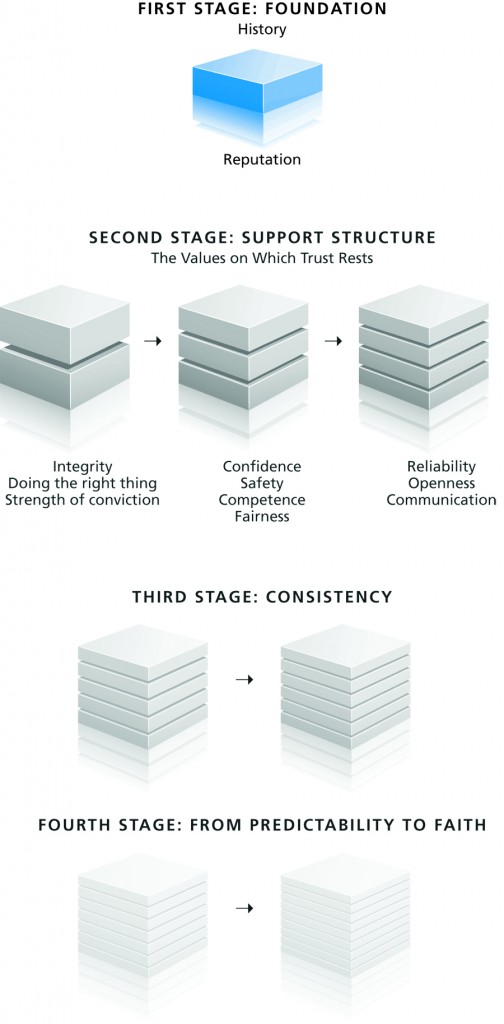Trust is never guaranteed, and it can’t be won overnight. Trust must be carefully constructed, vigorously nurtured, and constantly reinforced. Trust is established over time, gradually, through a long chain of successful experiences. The following paragraphs describe how to build trust.
Building trusting relationships is a process that can best be described as stacking layers on a foundation one at a time in such a way that each layer bonds on top of the prior one before another layer is added. This model is described in Creating Trust: A Step-By-Step Guide.
First Stage of Trust: The Foundation
The past is often the best indicator of the future; we all look for precedents as a key to anticipating behavior. We want to know how someone acted in the past when faced with a similar situation. Last time I confided in her, was she able to keep a secret? Last time he promised he would deliver it on time, did he keep his word? Last time I loaned him money, was it paid back? Last time they sold me a product, did they stand behind it? Last time there was a downturn in the economy, how were employees treated? Last time we presented an idea to management, who took the credit for it? Last time there was a problem in the department, did management support us or look for a scapegoat? Last time we faced tough times, did management stand behind its people or fend for themselves?
Whether you are an organization trying to gain trust in the marketplace or a salesperson trying to gain the trust of a consumer, keep in mind that trust is not won instantly; instead, it is earned by consistent actions repeated over time. Similarly, organizations become trustworthy by repeating their actions over the years. Organizations that institutionalize the value and importance of lifelong customer relationships over immediate sales transactions know that winning an immediate sale is not as important as exceeding customer expectations over time. They know that signing a sales agreement is not the end of the sales process, but the beginning of the next sale. They know that the minute a purchase is made, and the consumer has placed trust in their organization, they must work hard to maintain that trust.
Reputation.The most tangible form of history is reputation. An individual’s or organization’s reputation is often a key to their probable behavior toward a friend, a client, or an employee; it indicates how they might treat others both now and in the future. That’s why, before we enter into a relationship, we ask ourselves if the person or organization is known to be a trustworthy individual or a good corporate citizen. It’s why we want to know how they have treated others when the chips were down or when they were backed into a corner.
Organizations that emphasize long, trusting relationships are rewarded in numerous ways. First, there is potential repeat business. Loyal customers may even look for other available products from your company. And once their trust in your organization grows, they may reward you by making larger purchases. Finally, long-term relationships encourage satisfied clients to tell their friends or colleagues about the great products and service that they are receiving from you.
In our next post, we’ll hone in on the second stage: “The Values on Which Trust Rests.”
Additional Reading:
Creating Trust: A Step-By-Step Guide
The Values on Which Trust Rests
Trust: How to Earn Someone’s Faith
Trust Me: 55 Ways to Build Trust and Credibility
If you like this article, subscribe to our blog so that you don’t miss a single post. Get future posts by RSS feed, email or Facebook. It’s FREE. Click your favorite option (top right).







Looking to rebuild a relationship after a lost of trust.